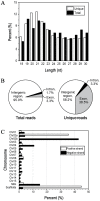Exploring microRNA-like small RNAs in the filamentous fungus Fusarium oxysporum
- PMID: 25141304
- PMCID: PMC4139310
- DOI: 10.1371/journal.pone.0104956
Exploring microRNA-like small RNAs in the filamentous fungus Fusarium oxysporum
Abstract
RNA silencing such as quelling and meiotic silencing by unpaired DNA (MSUD) and several other classes of special small RNAs have been discovered in filamentous fungi recently. More than four different mechanisms of microRNA-like RNAs (milRNAs) production have been illustrated in the model fungus Neurospora crassa including a dicer-independent pathway. To date, very little work focusing on small RNAs in fungi has been reported and no universal or particular characteristic of milRNAs were defined clearly. In this study, small RNA and degradome libraries were constructed and subsequently deep sequenced for investigating milRNAs and their potential cleavage targets on the genome level in the filamentous fungus F. oxysporum f. sp. lycopersici. As a result, there is no intersection of conserved miRNAs found by BLASTing against the miRBase. Further analysis showed that the small RNA population of F. oxysporum shared many common features with the small RNAs from N. crassa and other fungi. According to the known standards of miRNA prediction in plants and animals, milRNA candidates from 8 families (comprising 19 members) were screened out and identified. However, none of them could trigger target cleavage based on the degradome data. Moreover, most major signals of cleavage in transcripts could not match appropriate complementary small RNAs, suggesting that other predominant modes for milRNA-mediated gene regulation could exist in F. oxysporum. In addition, the PAREsnip program was utilized for comprehensive analysis and 3 families of small RNAs leading to transcript cleavage were experimentally validated. Altogether, our findings provided valuable information and important hints for better understanding the functions of the small RNAs and milRNAs in the fungal kingdom.
Conflict of interest statement
Figures




References
-
- Romano N, Macino G (1992) Quelling: transient inactivation of gene expression in Neurospora crassa by transformation with homologous sequences. Molecular microbiology 6: 3343–3353. - PubMed
-
- Bass BL (2000) Double-stranded RNA as a template for gene silencing. Cell 101: 235–238. - PubMed
-
- Song J-J, Smith SK, Hannon GJ, Joshua-Tor L (2004) Crystal structure of Argonaute and its implications for RISC slicer activity. science 305: 1434–1437. - PubMed
Publication types
MeSH terms
Substances
LinkOut - more resources
Full Text Sources
Other Literature Sources
Research Materials

